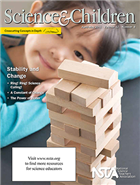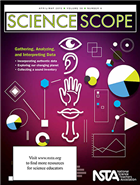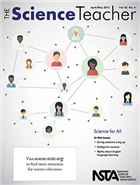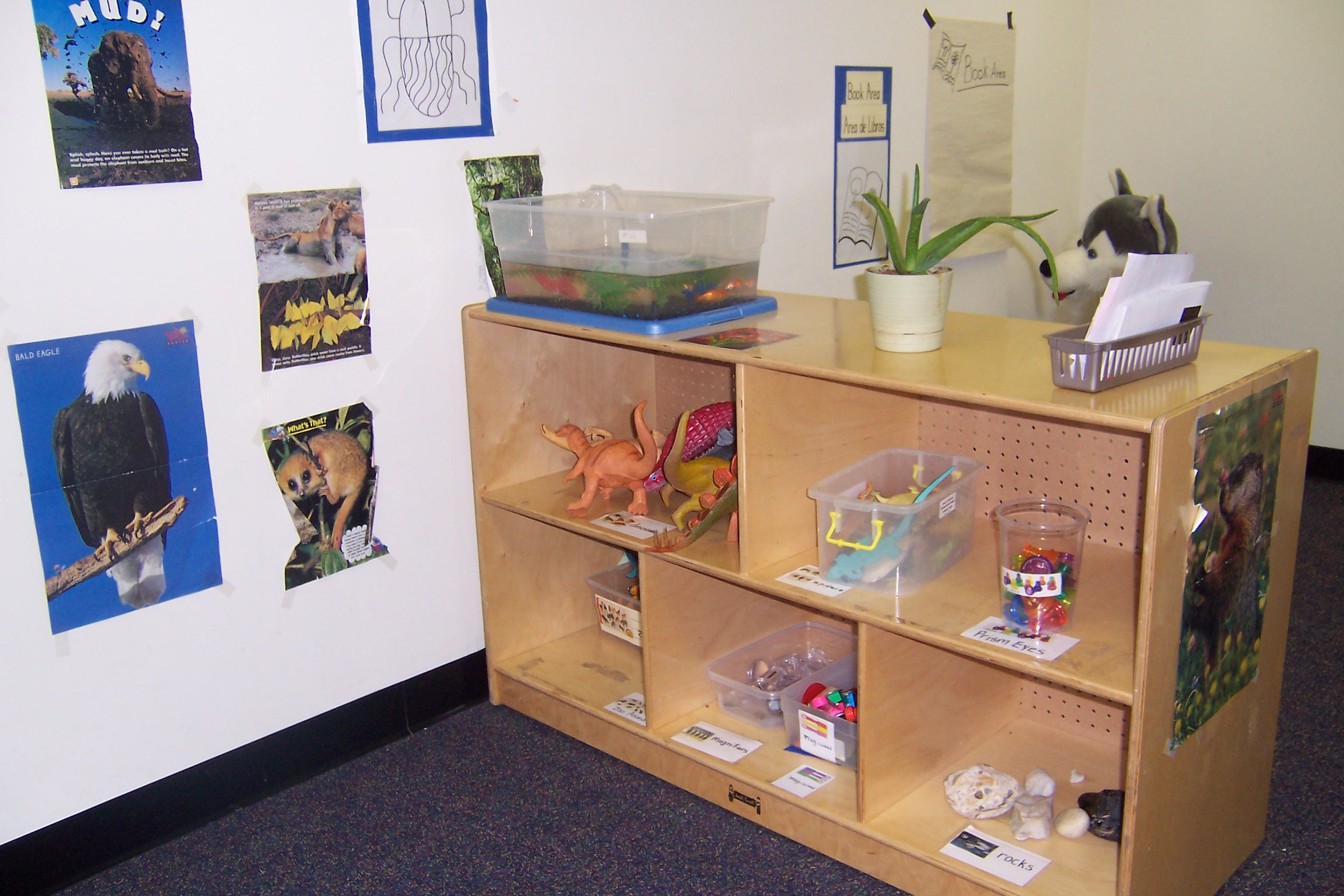Systems: "Science Areas" and lining-up for transitions
By Peggy Ashbrook
Posted on 2015-05-31
Organizing systems for materials and people are necessary for a productive day in school. If they are held in common by the school or classroom community they operate smoothly. Sometimes changes made by an individual interrupt the flow. In those moments we can re-consider our systems and decide whether to keep the changes or return to the original plan.
Here are some systems that I’ve seen in preschools and the questions that I’ve been considering about them. You can help me think about these systems by adding a comment below to share your own questions or advice.
Science centers
Systems can identify areas for particular tools and activities, providing children with the materials and space they need for particular kinds of play–creating artwork and writing, playing dress-up and telling stories, reading a book, building a block structure in a protected space, and using tools to look at living organisms. Some curricula require certain centers or areas, and signs to identify them: Housekeeping, Art, Blocks, Writing, Circle, Library and Science. Having a print-rich environment, including signage, is part of developing children’s literacy.
By posting an area as the “Science Area,” early childhood educators may promote teaching science by making teachers, children and parents aware that science education is part of the curriculum. Identifying science learning as a part of the daily routine teaches children that they can participate in science. But do we need to have a “Science Center”? The word “Science” is visible; however, the label might make us unconsciously limit where science investigations happen, and therefore not integrate thinking about science concepts into the daily schedule. Examining the shapes of and sorting a box of seashells, combining sets of blocks to build a “super big” rocket, experiencing the properties of matter while working in the sensory table or making playdough—science (and engineering) explorations happen in all parts of a classroom not only in a center. Should there also be “Technology,” “Engineering,” and “Math” areas if a program uses the acronym “STEM” to describe the curriculum?
A “Science Area” is a handy place to store or display a rock collection, set of x-rays, or a terrarium but do those displays invite children to interact with the materials and do they ever change? How do you keep the area fresh and interesting? How do you make participation in science and engineering practices and thinking about concepts part of your everyday routine?
Systems for lining up students to move to another space
Transitions from one space to another take time. Accepting this is one way to lessen feelings of frustration. We can also create systems to make these times shorter, fun, opportunities for connecting socially, and learning opportunities. Here is one system that is used by a class of four-year-olds to move from the classroom to the playground and back again, making sure all children are there.
 The numbers from 1 to 18 are posted on the floor in the place to line up, both in numerals and the same number of object pictured on the same square. The teachers have a paper listing children’s names with spaces next to them on a clipboard. Every day teachers pencil in a new order of numbers next to the names. The numbers move down a space and the last number moves to the first
The numbers from 1 to 18 are posted on the floor in the place to line up, both in numerals and the same number of object pictured on the same square. The teachers have a paper listing children’s names with spaces next to them on a clipboard. Every day teachers pencil in a new order of numbers next to the names. The numbers move down a space and the last number moves to the first  name in the list. The children line up on the squares according to their place that day. They verify their spot by reading the numeral or counting the objects. In the beginning, the children need reminders about which number they “are” that day. Since they line up several times a day, five days a week, they soon remember where they were the day before and place themselves accordingly. If the interactions between children in line become disruptive, the order can be changed by drawing numbers or teacher choice. Children become familiar with the numerals, counting sets and participating in a system for moving people.
name in the list. The children line up on the squares according to their place that day. They verify their spot by reading the numeral or counting the objects. In the beginning, the children need reminders about which number they “are” that day. Since they line up several times a day, five days a week, they soon remember where they were the day before and place themselves accordingly. If the interactions between children in line become disruptive, the order can be changed by drawing numbers or teacher choice. Children become familiar with the numerals, counting sets and participating in a system for moving people.
Many, many more systems for lining up are available online by searching for “how to line up in preschool”. The New Mexico PreK Resources page on Transitions with information from High Scope sources asks us to consider why children need to line up. Does your system work well?
Organizing systems for materials and people are necessary for a productive day in school. If they are held in common by the school or classroom community they operate smoothly. Sometimes changes made by an individual interrupt the flow. In those moments we can re-consider our systems and decide whether to keep the changes or return to the original plan.
Here are some systems that I’ve seen in preschools and the questions that I’ve been considering about them. You can help me think about these systems by adding a comment below to share your own questions or advice.
Science for all
By Mary Bigelow
Posted on 2015-05-30

The most recent NSTA K-12 journals have suggestions, lesson ideas, and resources for helping all students engage with the disciplinary content, crosscutting concepts, and science and engineering practices that make up the NGSS.
Science & Children — Stability and Change
Although this may sound like an oxymoron (“the more things change, the more they stay the same?”), this is actually one of the NGSS crosscutting concepts. It’s one that would be appropriate for many topics in the general sciences: Newton’s Laws, equilibrium, food webs, body systems, weather and climate, plate tectonics, other systems studies.
Here are some SciLinks with weblinks for content information and suggestions for additional activities and investigations related to this month’s featured articles:
- Ring! Ring! Science Calling! [SciLinks: Genetics]
- A Constant of Change [SciLinks: Sun]
- What Happens When An Environment Changes? [SciLinks: Food Chains
- The Power of Water [SciLinks: Water Erosion, Severe Storms]
- Teaching Through Trade Books: The Earth’s Changing Surface [SciLinks: Dynamic Earth, Water Erosion, Earthquakes, What processes change landforms?]
- Formative Assessment Probes: No More Plants [SciLinks: Ecosystems, Food Chains and Food Webs]
- Methods and Strategies: Garden-Based Learning: It’s Just the Berries! [SciLinks: Factors Affecting Plant Growth]
- Science 101: How Does Stable Equilibrium Differ From Other Kinds of Equilibrium? [SciLinks:
- The Early Years: Recognizing Stability and Change [SciLinks: What Are Systems?]
 Science Scope — Gathering, Analyzing, and Interpreting Data
Science Scope — Gathering, Analyzing, and Interpreting Data
The lessons described here (many of which illustrate the 5E model), illustrate the integration of NGSS disciplinary core ideas and crosscutting concepts with science and engineering concepts related to the collection, analysis, interpretation, and communication of data. The articles feature traditional methods as well as technology software and apps.
Here are some SciLinks with weblinks for content information and suggestions for additional activities and investigations related to this month’s featured articles:
- Using the Scientific Process to Engage Students With Our Changing Planet [SciLinks: Changes in Climate, Changes in Ecosystems, Biotic and Abiotic Factors, Ecosystems]
- Exploring Sound! Using Tablets in Middle School Science [SciLinks: Properties of Sound, Sound Quality]
- Using Authentic Data to Enhance Middle School Atmospheric Science Instruction [SciLinks: Tornadoes, Severe Weather, Storms]
- “Nor Any Drop to Drink” Students Engineer Solutions for Desalinating Ocean Water [SciLinks: Desalination, Water Quality]
- Teaching With Tarantulas [SciLinks: Arachnida]
- Let Them Eat Cake …OE-Cake! [SciLinks: Phase of Matter, Density]
- Tried and True: The Science of Bending Light [SciLinks: Refraction, Properties of Light]
 The Science Teacher — Science for All
The Science Teacher — Science for All
As the editor notes, “More often than not, high-quality teaching strategies like those in this issue benefit students well beyond the targeted group.” There are many suggestions for including all students in learning science, including special needs students and English language learners.
Here are some SciLinks with weblinks for content information and suggestions for additional activities and investigations related to one of this month’s featured articles:
- Making Molecular Movies [SciLinks: Polymers]

The most recent NSTA K-12 journals have suggestions, lesson ideas, and resources for helping all students engage with the disciplinary content, crosscutting concepts, and science and engineering practices that make up the NGSS.
Science & Children — Stability and Change
Based on the award-winning, best-selling Picture-Perfect STEM series, this ClassPack pairs effortlessly with the Picture-Perfect STEM Grade 1 Lesson "Sunset and Shadow Play" to combine reading comprehension, literacy, and science in your classroom! Corresponding lesson Children's Book Packs are available for purchase seperately.
Based on the award-winning, best-selling Picture-Perfect STEM series, this ClassPack pairs effortlessly with the Picture-Perfect STEM Grade 1 Lesson "Sunset and Shadow Play" to combine reading comprehension, literacy, and science in your classroom! Corresponding lesson Children's Book Packs are available for purchase seperately.
Picture-Perfect Science/STEM Lessons are created by classroom veterans Karen Ansberry and Emily Morgan. They know elementary educators are crunched for science instructional time and could often use refresher explanations of scientific concepts.
Picture-Perfect Science/STEM Lessons are created by classroom veterans Karen Ansberry and Emily Morgan. They know elementary educators are crunched for science instructional time and could often use refresher explanations of scientific concepts.




